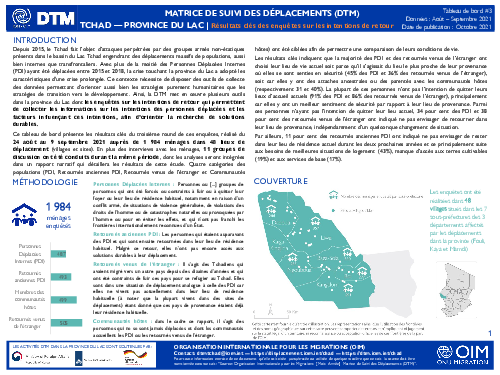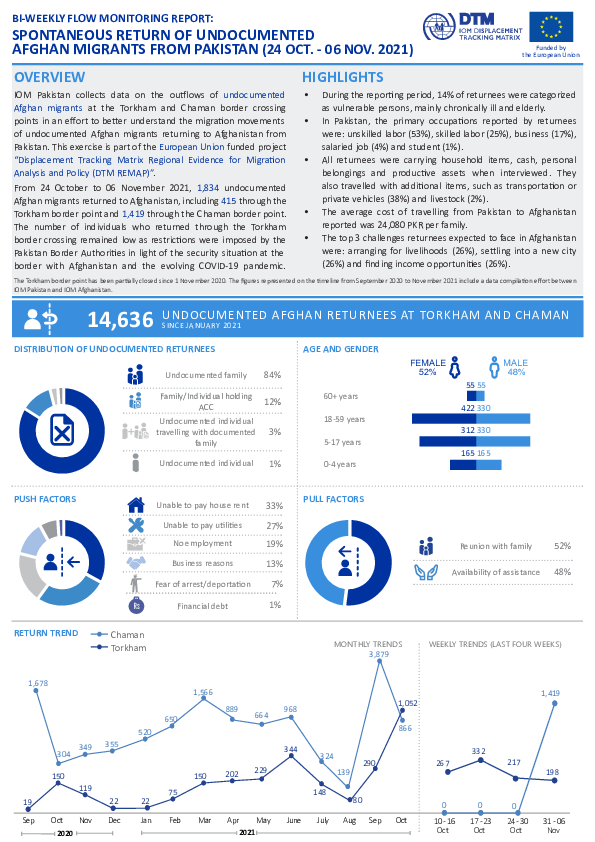-
Countries
-
Data and Analysis
-
Special Focus
-
Crisis Responses

Contact
DTM Chad, dtmtchad@iom.int
Language
English
Location
Chad
Period Covered
Aug 01 2021
Sep 30 2021
Activity
- Survey
- Return Intention
Depuis 2015, le Tchad fait l’objet d’attaques perpétrées par des groupes armés non-étatiques présents dans le bassin du Lac Tchad engendrant des déplacements massifs de populations, aussi bien internes que transfrontaliers. Avec plus de la moitié des Personnes Déplacées Internes (PDI) ayant été déplacées entre 2015 et 2018, la crise touchant la province du Lac a adopté les caractéristiques d'une crise prolongée. Ce contexte nécessite de disposer des outils de collecte des données permettant d’orienter aussi bien les stratégies purement humanitaires que les stratégies de transition vers le développement. Ainsi, la DTM met en œuvre plusieurs outils dans la province du Lac dont les enquêtes sur les intentions de retour qui permettent de collecter les informations sur les intentions des personnes déplacées et les facteurs influençant ces intentions, afin d’orienter la recherche de solutions durables. Ce tableau de bord présente les résultats clés du troisième round de ces enquêtes, réalisé du 24 août au 9 septembre 2021 auprès de 1 984 ménages dans 48 lieux de déplacement (villages et sites). En plus des interviews avec les ménages, 11 groupes de discussion ont été conduits durant la même période, dont les analyses seront intégrées dans un rapport narratif qui détaillera les résultats de cette étude. Quatre catégories des populations (PDI, Retournés anciennes PDI, Retournés venus de l’étranger et Communautés hôtes) ont été ciblées afin de permettre une comparaison de leurs conditions de vie.

Contact
DTM Chad, dtmtchad@iom.int
Language
English
Location
Chad
Period Covered
Aug 01 2021
Sep 30 2021
Activity
- Survey
- Return Intention
Since 2015, there has been an increase in attacks by non-state armed groups in Chad, specifically in the Lake Chad Basin area, resulting in massive internal and cross-border displacement. The crisis affecting the Lake Province has adopted the characteristics of a protracted crisis, with more than half of Internally Displaced Persons (IDPs) having been displaced between 2015 and 2018. This context requires data collection tools to guide both humanitarian and nexus strategies. Thus, the Displacement Tracking Matrix (DTM) implements several tools in the Lake Province, including return intention surveys, which aim at collecting information on the intentions of displaced persons and the factors influencing these intentions, in order to inform the development of durable solutions.
This dashboard presents key findings from the third round of return intention surveys in the Lake Province, conducted from 24 August to 9 September 2021, with 1,984 households in 48 displacement locations (villages and sites). In addition to household interviews, 11 focus groups were conducted within the same period, whose analyses will be incorporated into a narrative report detailing the results of this study. Four categories of populations (IDPs, former IDP returnees, returnees from abroad, and host communities) were surveyed to make a comparison of their living conditions

Contact
iomisbdtmremapteam@iom.int
Language
English
Location
Pakistan
Period Covered
Sep 24 2021
Nov 06 2021
Activity
- Flow Monitoring
From 24 September to 06 November 2021, 1,834 undocumented Afghan migrants returned to Afghanistan, including 415 through the Torkham border point and 1,419 through the Chaman border point. The number of individuals who returned through the Torkham border crossing remained low as restrictions were imposed by the Pakistan Border Authorities in light of the security situation at the border with Afghanistan and the evolving COVID-19 pandemic.

Contact
DTM Pakistan, iomisbdtmremapteam@iom.int
Language
English
Location
Pakistan
Period Covered
Jul 01 2021
Sep 30 2021
Activity
- Flow Monitoring
IOM Pakistan collects data on the outflows of undocumented Afghan migrants at the Torkham and Chaman border crossing points in an effort to better understand the migration movements of undocumented Afghan migrants returning to Afghanistan from Pakistan. This report is part of the European Union funded project ‘‘Displacement Tracking Matrix Regional Evidence for Migration Analysis and Policy (DTM REMAP)”.
This edition of ‘A Region on the Move’ covers the first six months of 2021 in the East and Horn of Africa region (EHoA). The current mid-year mobility overview provides an outline of some of the main socio-political events that occurred between January and June 2021, as well as an overview of the main population movement trends that affected the region. Migration flows are of particular importance in the region, as mobility is used both as a coping mechanism and an economic engine.
The outbreak of COVID-19 has affected global mobility through various travel disruptions and restrictions. To better understand how the pandemic affects global mobility, the International Organization for Migration (IOM) has developed an online tool and database to register points of entry (POE), exit and transit, where mobility restrictions and response measures are in place. To support these efforts, the Displacement Tracking Matrix Regional Evidence for Migration Analysis and Policy (DTM REMAP) team in Pakistan mapped and gathered data on the current statuses of POEs in the country.
Between September and October 2021, the DTM REMAP team in Pakistan monitored 17 POEs. These included nine airports, six land borders and two blue borders. The status of various POEs changed significantly between September and October 2021 due to a decrease in COVID-19 cases, changes to the security situation and fluctuations in national and international mobility restrictions. At the end of September, twelve POEs were fully operational, four were partially operational and one was fully closed.
At the end of October, twelve POEs were fully operational, three were partially operational and two were fully closed. On 2nd September, the Chaman bording crossing was temporarily closed due to security concerns. Because of similar security concerns, on 13th September the Torkham border was closed for pedestrians. However, it was opened a day later exclusively for Afghan nationals entering Afghanistan. On 29th September, the Taftan border crossing with the Islamic Republic of Iran was closed from both sides causing major disruptions and suspension of trade. In early October, the Chaman border crossing was closed again by the authorities due to security concerns. This caused major disruptions for traders and travelers on both sides of the border. The Civil Aviation Authority (CAA) issued a new advisory that made COVID-19 vaccination certificates mandatory for air travel starting from 1st October for passengers aged 18 years old and above. As per the latest directives, international and domestic travel would not be allowed without COVID-19 vaccinations after 30th September. CAA also updated the number of Category-C countries (International travel to Pakistan from the ‘Category-C’ countries is banned) from 23 to 12 for inbound travel to Pakistan.
The outbreak of the COVID-19 pandemic at the beginning of 2020 has affected global and regional mobility, including mobility in the DTM REMAP project countries, through various travel disruptions and restrictions. To better understand how the pandemic affects global mobility, the International Organization for Migration (IOM) developed an online tool and database to register points of entry, exit and transit - such as airports and land and blue border crossing points - where mobility restrictions and preparedness and response measures are in place. To support these efforts, over a period of 12 months, the Displacement Tracking Matrix Regional Evidence for Migration Analysis and Policy (DTM REMAP) national teams mapped and gathered data on the locations, statuses and restrictions at Points of Entry (PoE) in the project countries. The information gathered allows more in-depth analysis to uncover specific trends related to the locations, statuses and restrictions of PoEs in these countries. During the reporting period, the number of assessed PoEs in the DTM REMAP project countries gradually increased from 155 to 2091 PoEs. The most common type of PoE reported in August 2021 was land borders (111), followed by airports (73) and blue borders (25). Areas of interest, populations of interest and internal transit points were also assessed but were not taken into account for further analysis in this snapshot.

Contact
DTM Ethiopia, SLOAddisAbabaDTM@iom.int
Language
English
Location
Ethiopia
Period Covered
Sep 01 2021
Sep 30 2021
Activity
- Flow Monitoring
In September 2021, a total of 20,910 movements were observed across five of Ethiopia's flow monitoring points (FMPs). It should be noted that data collection at Humera Flow Monitoring Point in Tigray region did not take place due to security and access constraints, thus affecting the total number of movements for the month. This represents an 8.9% decrease in daily average movements in comparison with August 2021 when an average of 765 movements per day were observed.
Despite the decrease in movements this month, outgoing movements during September have continued to be higher than ever (85.3%) than incoming movements (14.7%). The percentage of outgoing versus incoming movements has continued to climb even above the proportions observed prior to the outbreak of COVID-19 in Ethiopia. A total of 17,828 outgoing movements were observed of which 8,991 (50.4%) were heading towards Saudi Arabia, 2,634 (14.8%) were going to Djibouti, 2,043 (11.5%) were travelling towards Kenya, 854 (4.8%) to South Africa, 674 (3.8%) intended to reach the United Arab Emirates, and 407(2.3%) headed to Qatar.

Contact
iomlesothoadmin@iom.int
Language
English
Location
Lesotho
Period Covered
Mar 01 2021
Jun 30 2021
Activity
- Flow Monitoring
This dashboard compiles flow monitoring survey (FMS) data collected in Lesotho between March and June 2021 and provides an analysis of migrants’ demographic and socio-economic profiles, including education and employment backgrounds; reasons for leaving their country of origin or habitual residence; future travel intentions; awareness of the COVID-19 outbreak; and challenges faced as a result of it.
In addition, the revised FMS form has also been enhanced with labour mobility and human development (LHD) indicators with a particular focus on the migrants’ highest level of educational qualification achieved and main subject areas, their employment status before migrating, as well as the impact of COVID-19 on remittances.
Majority of migrants interviewed are from Lekhalong in Mafeteng district and most of them are Basotho. During this four months (March to June), a total of 777 surveys were conducted in four districts, Basotho (715), South Africa (52) and Others (10). Most of the respondents were adult males (52%) and female (48%). Most respondents displayed awareness of the ongoing COVID-19 pandemic (99%). Most of respondents from Lesotho where originary from Mohaleshoek, representing 43% per cent, followed by respondents from Mafeteng (39%),followed by Qacha’s Neck (10% and Quthing (8%)
Contact
DTM Yemen, iomyemendtm@iom.int
Location
Yemen
Activity
- Event Tracking
- Mobility Tracking
Period Covered
Nov 07 2021 -Nov 13 2021
Activated on an ad hoc basis, the DTM Emergency Tracking provides early field reports at the beginning of a complex crisis, allowing IOM to gather, consolidate and disseminate baseline information on displacement and return figures at the onset of a newly emerging crisis. The DTM Emergency Tracking relies heavily on information provided by RARTs or partners within the humanitarian community about an unfolding situation. The Emergency Tracking gathers data through IOM Iraq’s extended network of key informants, who provide basic information on the new displacement, be it of IDPs or returnees, or both, including numbers, location and shelter types. While IOM DTM strives to provide best estimates, the Emergency Tracking aims to be a quick monitoring tool with real-time data turnover ranging from 24 to 72 hours following its activation. As displaced population movements are highly fluid, these emergency early reports require continuous verification through multiple sources and data triangulation. Eventually, the DTM Emergency Tracking data feeds into the displacement data within the two-week DTM Master Lists reporting cycle and, therefore, data will be later verified and assessed through other components of the DTM methodology.
Population Groups
Survey Methodology
Unit of Analysis Or Observation
Type of Survey or Assessment
Keywords
Geographical Scope
Administrative boundaries with available data
The current dataset covers the following administrative boundaries



